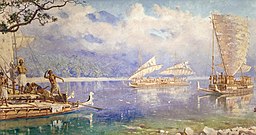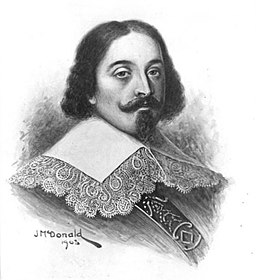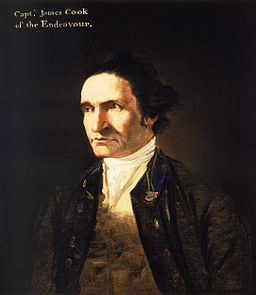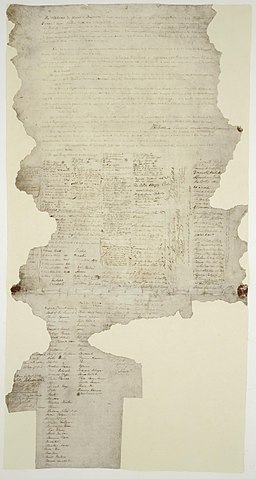New Zealand
New Zealand, or Aotearoa (Māori name for New Zealand), was first reached by settlers from Eastern Polynesia sometime near the end of the 13th century.[1] They came to be known as Māori and are the indigenous people of New Zealand. They quickly developed a distinct society and culture that lives on to this day.
Abel Tasman, a Dutch explorer, made the first European sighting in December 1642. He anchored his ship at the north end of the South Island near Golden Bay. However, due to the Māori people's strong efforts to protect their land and a fear of the unknown by both parties, things turned violent and Tasman never stepped foot on the islands of New Zealand, or as he first recorded it, "Nieuw Zeeland."
English explorer, James Cook, travelled there in October 1769 and was the first European to land and navigate New Zealand.[4] Cook recorded his first encounters with the Māori as peaceful and due to his good reports back to England, immigration quickly followed. By 1916, there were over a million Pākehā (non-Māori New Zealanders) in New Zealand. It was viewed as a lush land of opportunity due to its abundance of natural resources. The majority of immigrants came from England, Wales, Scotland, and Ireland with many of them being whalers, sealers, or missionaries who hoped to bring Christianity to New Zealand.[5] Christianity was first brought to New Zealand in 1814 by Samuel Marsden, who was an English priest for the Church of England, when he founded a mission at the Bay of Islands on the North Island.[6] Sadly, this massive wave of European migration also brought diseases such as influenza, dysentery, and diphtheria to New Zealand which severely hurt the Māori population since they had no immunity to these illnesses.[7]
The subsequent influx of European settlers immigrating to New Zealand led to the turbulent period known as the New Zealand Wars, or Land Wars, which lasted for over 25 years (1845-1872). The British New Zealand Company was formed in 1838, which then started buying land from the Māori Tribes and selling it to settlers who had made the long arduous journey from Britain to Aotearoa to start a new life. In 1839, The New Zealand Company, who planned to colonize New Zealand and establish an English society in the southern hemisphere, began moving forward with their plans. They are responsible for settlements at Wellington, Nelson, Wanganui, Dunedin, New Plymouth, and Christchurch.[9]
On February 6, 1840, The Treaty of Waitangi was signed by members of the British crown and eventually over 500 Māori chiefs. The Treaty established that all citizens of New Zealand would have the same rights as those of Great Britain and gave them authority over their own land, but also granted Queen Victoria and her government total sovereignty of New Zealand. In 1974, February 6th became a national holiday in New Zealand and it is celebrated annually as Waitangi Day. [10]
On July 1, 1841, New Zealand was established as its own colony. The first government of New Zealand was formed in 1856 with Henry Sewell as the first Premier, later renamed the Prime Minister. On September 16, 1907, Dominion Day, at the 1907 Imperial Conference, King Edward VII declared New Zealand a Dominion, therefore it was no longer the Colony of New Zealand.
New Zealand Settlements
Immigration to New Zealand first began when Polynesians settled there between 1250 and 1280. This migration lead to the start of the Māori culture and language. The Māori culture strongly resembles that of the Cook and Society Islands, therefore most researchers believe this is where they originated before settling in New Zealand. The Moriori people settled in the Chatham Islands after leaving New Zealand's South Island during the 15th century.European immigration to New Zealand began to grow due to the British colonies in Australia and the increase in popularity of whaling and sealing, which was plentiful in the Southern Ocean. By 1830, roughly 800 non-Māori people were living in New Zea-land, which included approximately 200 escaped convicts from Australia. By 1839, there were 1,100 Europeans solely on the North Island.
After the Treaty of Waitangi was signed on the 6th of February 1840, European immigration to New Zealand began to increase. The Treaty was signed in order to establish a British Governor General of New Zealand and to legally give the Māori people the same rights as British citizens and all European immigrants. The Treaty of Waitangi is considered the founding document of New Zealand and Waitangi Day is now a national holiday that has been celebrated annually on February 6th since 1974.
Today, New Zealand is a multicultural society and was the first country to declare itself Nuclear Free.
References
- ^ Walters, Richard; Buckley, Hallie; Jacomb, Chris; Matisoo-Smith, Elizabeth. "Mass Migration and the Polynesian Settlement of New Zealand". Journal of World Prehistory, 2017.
- ^ "File:Rotorua Museum, Maori arrival.jpg." Wikimedia Commons, the free media repository. 17 May 2016, 08:39 UTC. https://commons.wikimedia.org/w/index.php?title=File:Rotorua_Museum,_Maori_arrival.jpg&oldid=196484413
- ^ "File:Abel Janszoon Tasman (11313033535).jpg." Wikimedia Commons, the free media repository. 16 Dec 2019, 03:06 UTC. https://commons.wikimedia.org/w/index.php?title=File:Abel_Janszoon_Tasman_(11313033535).jpg&oldid=380609769
- ^ Sivignon, Cherie "Commemoration plans of first encounter between Abel Tasman, Māori 375 years ago". Stuff, 2017.
- ^ Ingram, C. W. N. New Zealand Shipwrecks 1975–1982. Auckland: New Zealand Consolidated Press, 1984.
- ^ Brandt, Agnes. Among Friends?: On the Dynamics of Māori -Pākehā Relationships in Aotearoa New Zealand. V&R Unipress GmbH, 2013.
- ^ Entwisle, Peter. "Estimating a population devastated by epidemics. Otago Daily Times. 2006.
- ^ "File:James Cook's portrait by William Hodges.jpg." Wikimedia Commons, the free media repository. 12 Aug 2018, 04:16 UTC. https://commons.wikimedia.org/w/index.php?title=File:James_Cook%27s_portrait_by_William_Hodges.jpg&oldid=314468468
- ^ McLintock, Alexander Hare; Lucas, Percy Hylton Craig. "Settlement from 1840 to 1852" from Te Ara, the Encyclopedia of New Zealand. Government of New Zealand,1966.
- ^ Orange, Claudia. The Treaty of Waitangi. Bridget Williams Books, 1987.
- ^ "File:Waitangi Sheet, Te Tiriti o Waitangi (15858996150).jpg." Wikimedia Commons, the free media repository. 10 Aug 2019, 01:25 UTC. https://commons.wikimedia.org/w/index.php?title=File:Waitangi_Sheet,_Te_Tiriti_o_Waitangi_(15858996150).jpg&oldid=361288798



